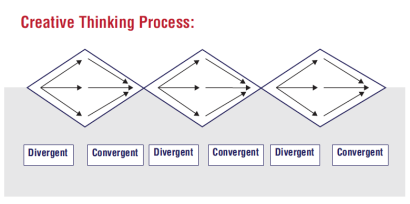|
By: Michael Donahue, CMAA, Director of Athletics - The School District of Philadelphia in Pennsylvania "Creativity is most likely to take place at When you read this quote, you might have said to yourself, "That is exactly where I am." As an athletic director, you are constantly trying to stay organized and keep chaos at bay. Despite this fact, however, many athletic directors do not have a sound understanding of creativity and innovation and how they can be implemented within their athletic departments. This is surprising given the fact many athletic directors, especially since the start of the COVID-19 pandemic, have had to exercise their creative and innovative muscles on a daily basis. Problems need to be solved and needs need to be met. So why design for creativity and innovation? The main lesson people tend to take from the writings of Charles Darwin is survival of the fittest. But I would argue that lesson misses the mark because the species that best survived were only the fittest due to their adaptability of the specific environment. Therefore, I would argue it is survival of the most adaptable, and athletic directors who can quickly adapt to their environment, and the many challenges it presents, are going to be the most successful. The process of adaptation requires creativity and innovation. Innovation springs from two sources. The first is needs driven. This source is what athletic directors encounter the most. It involves identifying a need and generating a number of ideas in order to address it. A few examples include creating a new inventory system for uniforms or devising new ways to generate revenue at athletic events. The second source of innovation is discovery driven. This requires the ability to recognize an unexpected or unforeseen opportunity that leads to the invention of something new and useful. To recognize such opportunities, an athletic director must be prepared to do so. This preparation will be further explained later, but athletic directors must be armed with a bias for action in order to take advantage of such opportunities. Another reason why athletic departments should be designed for creativity and innovation is because it provides for a competitive advantage on and off the field. On the field, if your teams come from an athletic department that emphasizes creativity and innovation, your teams will seek to rapidly adapt in game to what their opponents are doing, and they will consistently keep their opponents off balance through a combination of inventive play design and execution.
Off the field, your athletic department will benefit from harnessing the collective brain power that already exists within it. Many minds are better than one, and creativity requires generating many ideas. The more brains that are engaged by your athletic department, the more likely it is to be innovative. Finally, an athletic department that emphasizes creativity and innovation will be fulfilling the greater mission of education, which is to prepare young men and women to be active and engaged citizens in society. To be an active and engaged citizen, one must prepare for a world where the pace of change is rapid and increasingly so. You must teach student-athletes how to keep up with the pace of change and be successful in an increasingly competitive and fast-paced world. A great way to do so is teaching them how to be the driver of change. We constantly hear about how we have entered into the creative economy. It is possible to use athletics to prepare young men and women for such an economy. Remember, interscholastic athletics is the continuation of education by other means. What is Creativity and Innovation? Creativity refers to an idea that is both original and appropriate. Another word often substituted for original is novel. For an idea to be considered creative it must be new in the given context. For example, the concept of dynamic ticket pricing was introduced by the San Francisco Giants in the late 2000s, but that concept had been used by airlines for many years prior. Creative ideas also must be appropriate in that they must serve some purpose, such as solving a problem or accomplishing a goal. There is no sense developing a better paper ticket system when digital ticketing systems are becoming more prevalent. It is not unusual to hear people use the words creativity and innovation interchangeably, but it must be understood that they mean different things. Creativity is the generation of new and useful ideas, and innovation is bringing those ideas to life. For example, you might get creative and come up with new ideas for a social media policy for your athletic department, but you still have to implement those ideas to ultimately pro-duce a document that will serve as the official policy. What is the Athletic Director's Job as the Creative Innovation Champion? First, you should recognize the value of creativity and study it to develop it in yourself and others. Like an athletic skill, creativity can be improved the more it is practiced. Set aside time to both study it and exercise it. This can be done by reading or watching videos. TED Talk has entire YouTube channels devoted to the topic. Keep an idea book or idea folder on your smartphone, and record ideas that might come to you at random times. It is common for new ideas to come to you when you are not actively thinking about them. Set time aside during athletic department meetings for the purpose of generating and reviewing new ideas for improving the way the department functions. Tanner and Reisman, in their book "Creativity As a Bridge Between Education and Industry Fostering New Innovations," listed the following as important characteristics of a creative innovation champion:
Servant leadership has been identified as the leadership style best suited to facilitate creativity and innovation within your athletic department. Servant leaders set clearly defined goals, determine and refine processes, and help navigate their followers through well-defined paths. You should not be the primary source of creative ideas but rather you set the conditions for creativity and encourage ideas to flow from others. Second, creativity and innovation should be promoted and modeled, especially by you, the athletic director. The power of example cannot be understated. Let it be known amongst the entire athletic community that you value everyone's ideas and you want to hear them. Demonstrate this by designing programs and policies for collecting stakeholders' ideas and making public the process for their review and possible implementation. Third, construct a creative environment for all your pro-gram's stakeholders. This means not only your coaching staff, but also your parents, alumni, and sponsors. The beauty of constructing a creative and innovative environment is it promotes engagement at all levels, which should be a goal of any athletic director. Remember that environments shape culture, and your goal in designing your creative environment is to make creativity and innovation a part of "this is what we do here." Principles for Design No two athletic department creative environments will be alike. It is important to remember that your department should always be a reflection of you and your community. However, all creative and innovative environments should be built upon some foundational principles. Here are a few suggestions for you to consider when building your creative environment.
Elements for Designing a Creative Environment In their book "Corporate Creativity: How Innovation and Improvement Actually Happen," Robinson and Stern listed the following as the six essential elements of corporate creativity:
Alignment refers to the degree to which the interests and actions of your athletic department support your key goals. It should not be a mystery to any key stakeholders what the mission and key goals are for your athletic department. They should be clearly spelled out in a publicly available document, and they should be reviewed at least annually. Creativity is very sensitive to alignment. It provides the framework and direction in which your staff will direct its creative efforts. The mission statement acts as the north star, and the key goals provide the path to get there. Most creative acts come from self-initiated activity. The Wright Brothers are a great example of this. They started working on the airplane for its own sake. It was a labor of love and they were intrinsically motivated. Your staff should feel encouraged to do the same thing, but directed toward improving the athletic department and especially the experience of the student-athletes. This could take the form of your coaches devising novel offensive or defensive schemes for their sports. Super Bowl champion coach Bill Walsh designed what became known as the "West Coast Offense" while he was assistant coach for Cincinnati University because his quarterback had a weak but accurate arm. Walsh encouraged his former assistant coaches to design their own plays and present them to coach Walsh. He had four offensive assistants coaches go on to win Super Bowls as head coaches themselves (George Seifert, Mike Holmgren, Mike Shannahan, and Brian Billick). Unofficial activity is closely related to self-initiated activity. Essentially, unofficial activity takes place within your athletic department but with no official sanction by the athletic director. In fact, this article is an example of an unofficial activity. Most of it was written at the end of my workdays. The point to take away is that unofficial activities should be encouraged, but you should also have a plan for what to do with them. Set aside time for staff members and key stakeholders to present what they have been working on. Make it an event. Google tells employees to set aside 20 minutes a day to work on whatever they want. Then they have what is called FedEx Day, where employees are expected to "deliver." Gmail was born out of an unofficial work activity. As mentioned earlier, serendipity is when "a fortunate accident meets with sagacity (keenness of insight)." Your staff should be prepared with an understanding of what serendipity means in order to identify fleeting moments of opportunity that must be taken advantage of. You should describe what those moments look like. This could take the form of a chance encounter with one of your prominent alumni who is looking to donate money to the athletic department. Diverse stimuli was also mentioned earlier. Take note of what sparks creative thoughts for you. Is it a picture? Music? An object? Or could it be a specific setting? Creativity can be sparked by anything from anywhere. Pay attention to when and where you have creative thoughts and prepare to capture them. Help others find what makes them creative and prepare them accordingly. We will relabel within company communication as within department communication. In other words, do your staff and key stakeholders know where to go to communicate a new idea with you, the athletic director? If not, then there could be a well of good ideas just sit-ting there within your athletic department going untapped. A simple suggestion system can do a lot of good, as well as how often you gather your staff and key stakeholders together and provide them opportunities to exchange ideas. Remember, creative environments are places where ideas flow freely, which provides the opportunity for them to be combined and recombined into potentially new and useful ways. These free-flowing environments are usually informal settings, such as happy hour or faculty lunchroom. Are you creating opportunities and physical spaces for these more informal moments to occur among your coaches and staff? Something as simple as a well-placed coffee maker or water cooler could provide such a place for coaches and staff to meet and have such exchanges. Practices to Avoid Premature Judgement will kill idea generation. You want to be sure that people feel safe to voice their ideas both privately and publicly. If their ideas are judged to be "bad ideas" out of hand, then they will stop trying to come up with new ideas or they will never share them if they do. You should make it clear that all ideas will be considered and evaluated in a way that is both fair and impartial. Therefore, remind yourself and your staff that your athletic department is a judgement free zone, and everyone should take off their white wigs until the appropriate time for the judgement of new ideas. Avoid idea squelchers. Essentially, idea squelchers are phrases people say to themselves and others when they first hear a new idea. In other words, it's how people "shoot down" new ideas. Here's a (very) short list:
Tanner and Reisman suggest the following four steps to "squelch the squelchers":
Quotas are killers of creativity. They have the same negative effect whether they are explicit or implicit. Requiring idea quotas often leads to spoof ideas, duplicate ideas, and misalignment. Spoof ideas are essentially the same idea restated multiple different ways. Duplicate ideas are self-explanatory but a natural result of requiring people to produce new ideas. Misalignment occurs with idea quotas because people start to focus only on producing ideas rather than focusing on the stated goals of the organization, or in this case your athletic department. Essentially, creativity needs to become part of your athletic department's culture, not creativity quotas. IAA
ABOUT THE AUTHOR: Michael Donahue, CMAA is the director of athletic administration at The School District of Philadelphia in Pennsylvania. He can be reached at mpdonahue@philasd.org. |










